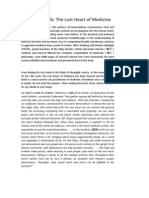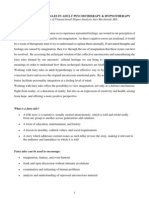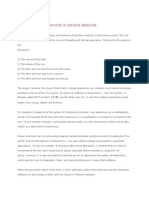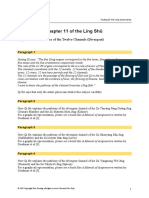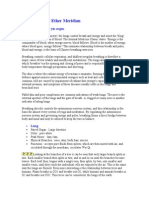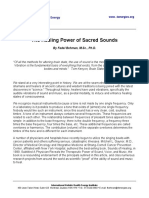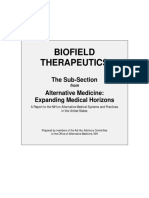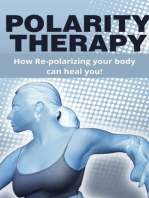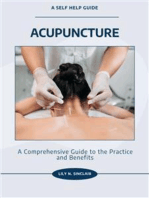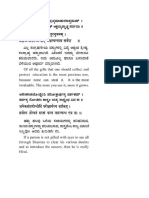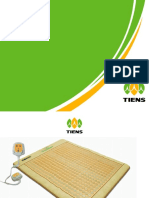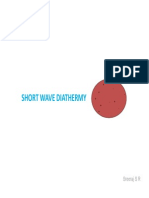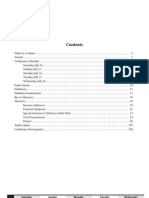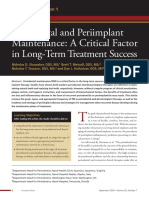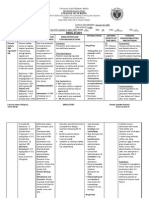100%(2)100% found this document useful (2 votes)
114 viewsFive Element Article PDF
Five Element Article PDF
Uploaded by
Prakash Aradhya RThis document provides an overview of Five Element acupuncture. It discusses how Five Element acupuncture treats the whole person - body, mind, and spirit. It explains the roots of Five Element acupuncture in Taoism and how it uses the concepts of qi, yin/yang, and the five elements to assess imbalances and treat the root of illness on any level. The five elements - Wood, Fire, Earth, Metal, and Water - correspond to organ systems, senses, emotions and more, and are used to diagnose the causative factor.
Copyright:
© All Rights Reserved
Available Formats
Download as PDF, TXT or read online from Scribd
Five Element Article PDF
Five Element Article PDF
Uploaded by
Prakash Aradhya R100%(2)100% found this document useful (2 votes)
114 views25 pagesThis document provides an overview of Five Element acupuncture. It discusses how Five Element acupuncture treats the whole person - body, mind, and spirit. It explains the roots of Five Element acupuncture in Taoism and how it uses the concepts of qi, yin/yang, and the five elements to assess imbalances and treat the root of illness on any level. The five elements - Wood, Fire, Earth, Metal, and Water - correspond to organ systems, senses, emotions and more, and are used to diagnose the causative factor.
Original Description:
Original Title
five-element-article.pdf
Copyright
© © All Rights Reserved
Available Formats
PDF, TXT or read online from Scribd
Share this document
Did you find this document useful?
Is this content inappropriate?
Report this DocumentThis document provides an overview of Five Element acupuncture. It discusses how Five Element acupuncture treats the whole person - body, mind, and spirit. It explains the roots of Five Element acupuncture in Taoism and how it uses the concepts of qi, yin/yang, and the five elements to assess imbalances and treat the root of illness on any level. The five elements - Wood, Fire, Earth, Metal, and Water - correspond to organ systems, senses, emotions and more, and are used to diagnose the causative factor.
Copyright:
© All Rights Reserved
Available Formats
Download as PDF, TXT or read online from Scribd
Download as pdf or txt
100%(2)100% found this document useful (2 votes)
114 views25 pagesFive Element Article PDF
Five Element Article PDF
Uploaded by
Prakash Aradhya RThis document provides an overview of Five Element acupuncture. It discusses how Five Element acupuncture treats the whole person - body, mind, and spirit. It explains the roots of Five Element acupuncture in Taoism and how it uses the concepts of qi, yin/yang, and the five elements to assess imbalances and treat the root of illness on any level. The five elements - Wood, Fire, Earth, Metal, and Water - correspond to organ systems, senses, emotions and more, and are used to diagnose the causative factor.
Copyright:
© All Rights Reserved
Available Formats
Download as PDF, TXT or read online from Scribd
Download as pdf or txt
You are on page 1of 25
Five Element Acupuncture:
Treating Body, Mind and Spirit
Charles A. Moss, M.D.
Five Element acupuncture as practiced in the West is a
distillation of traditional concepts from Chinese medicine
which emphasizes treating the whole person: body, mind
and spirit. Many of the current practitioners of this heal-
ing art have been trained by J.R. Worsley, who has cap-
tured the essence of this remarkable system and bril-
liantly applied it to the dilemmas and challenges of mod-
ern life. This article reflects the training I had with Wors-
ley and my experience of applying it over 25 years in a
primary care medical practice.
The Five Element acupuncture system, rooted in Taoism,
is over 2000 years old yet in many ways is more applica-
ble today than ever before. Five Element acupuncture
brings a vision and understanding of how to assess and
treat the roots of illness, whether on a body, mind or
spirit level. In today’s culture, with its emphasis on striv-
ing for material wealth, as well as the overwhelming
mental stimulation, there is little to nurture the spirit.
This has led to the clinical finding that many individuals
today have the origin of their health problems on the
spirit level.
The Tao Te Ching discusses protecting the spirit through
the state of desirelessness (wu wei). (1) The knowledge
that addressing the spirit is critical is also found in the
earliest writings in Chinese medicine, the Nei Ching Su
Wen "the first method of acupuncture is to cure the spir-
it, the second was to give knowledge of how to restore
the body. In order to make acupuncture effective one
must first cure the spirit. (2) The gift of Five Element ac-
upuncture is to make available the wisdom and under-
standing of these classical concepts of acupuncture for
the challenges of life at the brink of the new millennium.
TAO AND THE FIVE ELEMENTS
The goal of Five Element acupuncture is to enhance per-
sonal alignment with what the ancient Taoists called the
Laws of Nature. When living in accordance with these
Laws, the health of the body, mind and spirit is support-
ed. These Laws include the concepts of Qi, Yinyang and
the Five Elements, the three key components of tradi-
tional Chinese philosophy . Qi is described as the vital life
force which animates all living things. In the Five Element
system, Qi is defined as Energy which is conducted
through the body in the meridian pathways which sup-
plies the organs and the body, mind and spirit. When the
Qi is balanced a person remains well, when imbalanced
illness can occur.
The Yinyang concepts originated in the fourth century
B.C. and explained natural phenomena as the "ceaseless
rise and fall of opposite yet complimentary forces" (3).
Yin and Yang are strictly translated as the shady side of a
hill (yin) and the sunny side of a hill(yang). The Yin quali-
ties of cold, interior, dark, stillness and potential and the
Yang qualities of light, heat, exterior, rising and activity
exist in relation to each other. Yin and Yang are continu-
ously interacting and are interdependent and transforma-
tive of each other. A dynamic balance of Yin and Yang is
characterized by health, an imbalance by disease.
The characterization of phenomena into two aspects of
correspondences (Yinyang) was further expanded in the
Five Element system. The Five Elements represents the
universal consistency of systematic links. (4) The Laws of
Nature direct all movement within these Five Elements.
Nature and man are the macrocosm and the microcosm
of these Laws. These Laws organize the movement of Qi
within the individual and provide the structure for diag-
nosis and treatment in the Five Element system.
In the time of the Han dynasty (200 B.C.), living in har-
mony with nature as a way of maintaining health was an
obvious need. If the cycles of the season and climactic
conditions were ignored, famine and illness certainly
would follow in the agrarian society of China. The Nei
Ching discusses the relationship of the natural laws as
follows, The interaction of the Five Elements brings har-
mony and everything is in order. At the end of one year
the sun has completed its course and everything starts
anew with the first season, which is the beginning of
Spring. This system is comparable to a ring which has
neither beginning nor end. (5)
In Chinese philosophy the natural laws that organize the
cycles of change in nature, such as the seasons, are the
same laws that organize human experience. Paramount
among these laws is the Law of Five Elements (Wu-
Hsing). The Five Elements divides human experience into
five distinct groupings. These Elements act as maps that
reflect all levels of human function, including, but not
limited to, the anatomic and physiologic functioning of
the organ systems. The levels of function range from bio-
chemical processes to the function of the person as a
whole ranging from behavior, psychological state, emo-
tions, spiritual state and intellect to relationships and ca-
reer. The Five Elements include Wood (liver and gall
bladder), Fire (heart, small intestine, triple heater, peri-
cardium), Earth (spleen, stomach), Metal (lung, colon)
and Water (kidney, bladder). Using the Five Element
ëmap,’ dysfunction occurring on any of these levels can
be placed in the appropriate context.
The Nei Ching states "A person is not sick because of a
disease, they are diseased because they are sick." (6)
When the vital energy (Qi) is balanced in body mind and
spirit, there is resistance to disease and an ability to
adapt to the ever changing demands and challenges of
modern life. The ability to be flexible in mental functions
such as beliefs, emotions and attitudes, as well as being
adaptable in our biochemistry and immunology, brings a
higher level of well being.
Five Element theory has been part of Chinese Medicine
from the 10th century B.C. These concepts first appeared
in several books on philosophy such as the Shu Ching,
the Li Chi and the Guan Dzu. (7) The first medical writ-
ings on the Five Elements were found in the Nei Ching Su
Wen written around 200 B.C. Further discussion was
found in the Nei Ching Ling Shu and the Nan Ching. The
Five Element concepts are part of not only medical theo-
ry, but are an integral aspect of all ancient Chinese cos-
mology and philosophy. (8) The principles of the Five El-
ements were used in aspects of society ranging from ag-
riculture to affairs of state. (To understand the history of
Five Element acupuncture in the West, I refer the reader
to the excellent book, In the Footsteps of the Yellow Em-
peror by Peter Eckman.) (9)
To impart an understanding of body, mind and spirit was
part of the Taoist physician’s approach in utilizing the
wisdom of the Five Elements and Tao. Living a life of bal-
ance and harmony within oneself and in the society was
the mark of living with Tao. The goal of the physician was
to assist patients in treating illness and to educate them
in the ways in which they were not following the Tao.
Herbs and medicines were frowned upon because they
hindered the understanding of the true reason a person
got ill. "The concept of acupuncture differed from that of
drug application in that it constantly reinforced the sys-
tem of correspondences, providing stimuli only when man
had not been able, owing to his own negligence or exter-
nal conditions, to balance his existence in the proper
way." (10)
FIVE ELEMENTS AND THE CYCLE OF LIFE
The clinical application of the Five Elements is based on
the system of correspondences. The correspondences in-
clude seasons and climactic conditions, as well as corre-
spondences within the person. (Figure 1)
Each Element has correspondences, including organ sys-
tems, sensory organs, tastes in food, color, emotional
state, physical and emotional symptoms, disease tenden-
cies and a general orientation toward life. (Figure 2)
Selected positive qualities corresponding to each Element
are illustrated in Figure 3.
The correspondences are used to organize the diagnosis
which incorporates the history and physical findings to
identify a root or causative factor. The causative factor is
the Element that, under internal or external stress, be-
comes imbalanced and initiates a state of dis-ease. (11)
To understand what these Elements represent in man it
is helpful to see each Element in relation to its seasonal
correspondence. The Wood Element corresponds to
Spring, which is a time of new growth, increasing activity
and longer days. In the individual, Wood corresponds to
having a vision of the future, having the ability to organ-
ize, plan and initiate action, and to express emotions, in-
cluding anger, in a healthy manner. Wood includes the
function of the biliary tract, liver, ocular system and mus-
culoskeletal system. When not in balance, the Wood Ele-
ment correspondences include difficulty in making deci-
sions, high levels of frustration, excessive need for con-
trol, inappropriate anger, difficulty relaxing, anxiety,
chronic muscular problems such as fibromyalgia, head-
aches (including migraine) and visual problems.
The Fire Element corresponds to Summer. This is the
time of greatest warmth and light, the longest days, the
greatest activity and luxuriant growth. In the individual
Fire correspondences include the ability to establish rela-
tionships, express love and sexuality, expansiveness, en-
thusiasm, passion, playfulness, joyfulness, warmth and
relaxation. The organ systems include the heart, small in-
testine, pericardium, and sympathetic and parasympa-
thetic nervous systems. When the Fire Element is not in
balance there is a lack of joy and warmth, difficulty in in-
timate relationships, depression, confusion and doubt,
low energy, digestive problems such as irritable bowel
syndrome, insomnia, cardiac disease and tinnitus.
The season for the Earth Element is Late Summer. This is
harvest time when food is plentiful and the warmth and
golden light of the Late Summer days create a sense of
relaxation and contentment. The organ systems of Earth
are the stomach, spleen, pancreas and all digestive pro-
cesses. In the individual, Earth corresponds to nourish-
ment, contentment, harvesting what is needed for self
and others, stability, security, empathy and caring. Earth
corresponds to the biological mother, as well Mother
Earth. When the Earth Element is not in balance we see a
person who can be obsessive, self centered, opinionated,
insecure and uncaring. The physical symptoms include
eating disorders, upper and lower gastrointestinal disease
including peptic ulcer disease and inflammatory bowel
disease, sinusitis, frontal headaches and all gynecological
disorders.
The season of the Metal Element is Autumn. This is a
time of decreasing light, increasing cold and shorter
days. Trees lose their leaves as they withdraw their ener-
gy internally. In the individual, the Metal Element repre-
sents internal resolve and strength, self worth, self es-
teem, vitality and endurance, as well as the ability to let
go of emotional upsets and grudges. The organ systems
are the lung, skin and colon. Metal represents the biolog-
ical and spiritual Father. When the Metal Element is out
of balance there can be depression and sadness, an ina-
bility to recover from loss, lack of inspiration, rigidity,
poor self esteem, excessive materialism and emotional
withdrawal. The physical symptoms include asthma, rhi-
nitis, eczema and other skin disorders, constipation and
lower bowel disorders.
The Water Element is correlated with Winter. This is the
darkest and coldest time of the year, when activity in the
plant kingdom occurs only deep in the roots. In the indi-
vidual, the Water Element represents energetic reserves,
the will to survive, courage, our ability to procreate,
movement and flow, self actualization, willpower, trust
and faith. The organ systems are the bladder, kidney,
bones and endocrine system. When out of balance, the
Water Element corresponds to fear and a struggle for
survival, a lack of reserves and deep fatigue, reduced
sexuality, timidity and a lack of trust in life and in other
people. The physical symptoms include fatigue and ex-
haustion, all disorders of the urinary tract, infertility, hy-
pertension, all endocrine disorders, lumbar syndromes,
ankylosing spondylitis and dental pathology.
OFFICIALS, FUNCTIONS AND LAWS
In Five Element acupuncture the function of the organs
and meridians are described by the term Officials. Porkert
(12) describes the Official (Orbs) as "defined not by
physical properties, but by its specific roles in the pro-
cessing, storage and distribution of vital energy and thus
the maintenance of life." In the case of the Wood Ele-
ment, the two Officials are the "Official of Decision Mak-
ing and Wise Judgment" (the Gall Bladder) and the "Con-
troller of Planning" (the Liver).
The Gall Bladder is "responsible for what is exact and
just." Determination and decision stem from it. The Liver
"holds the office of general... assessment of circumstanc-
es and conception of plans stems from it."(13) When the-
se officials are poorly functioning, the effect might be in-
decisiveness, lack of initiative, anger and frustration, or
hypochondria with constantly changing symptoms. Deci-
sions relating to career or relationships might be repeat-
edly flawed and lead to stress and agitation. The ability
to make appropriate plans is affected and disturbance in
the 'blueprint' for functioning on a cellular level (i.e. dia-
betes), or a global level (i.e. drug addiction) might be the
outcome. This might be more significant than the physi-
cal manifestation such as headaches, dizziness, myalgias,
chest pain, or eye disorders which are often attributed to
Gall Bladder and Liver.
The Officials give us the ability to use a ëwide angle lens’
to look at the life style that a person has created as a re-
flection of the functioning of the Elements. Understanding
the behavioral manifestation of the Official often provides
insight into the dynamics behind chronic illness. In the
Wood Element, repeatedly making decisions which un-
dermine an individual’s well being reflects poor function-
ing of this Official. This information is critical in Five Ele-
ment diagnosis. Figure 4 has a list of the Officials and the
corresponding Element and organ. (14)
Understanding the functioning of the Officials and Ele-
ments and the acupuncture laws provides the organiza-
tion of symptoms and signs needed to provide effective
treatment. The laws which govern the movement of en-
ergy within the person are reflective of the physical laws
of nature. The Law of Five Elements (Wu-Hsing) (Figure
1) describes the Elements as energetic capacities that
create transformation and change, observable in Nature
as well as in the person. There is a set relationship be-
tween these Elements which is repeatable and observable
in nature. The movement through these Elements reflects
the nature of human experience from birth to death.
The energy of the Five Elements move through a creative
cycle and a controlling cycle. (Figure 6) The creative cy-
cle (also called engendering, productive, Sheng) is best
understood using the macrocosmic Images of the Ele-
ments. The Sheng cycle can be seen in this traditional
description: Water produces plants/trees, that is Wood;
Wood brings forth Fire; Fire produces ashes, that is soil
(Earth); soil brings forth Metal; when heated Metals pro-
duce steam, that is Water. The controlling cycle (Ke) is
illustrated as follows: Water overcomes fire through inhi-
bition; Fire activates Metal; Metal structures Wood; Wood
penetrates Earth; Earth absorbs water.
These two sequences form the basis for health and when
not in balance provides the understanding of the devel-
opment of disease. A clinical example is a patient who
has a history of low back pain with sciatica who has not
responded to acupuncture or other treatments directed at
the back pain itself. Her history revealed that she had ec-
zema and asthma as a child and the onset of the back
pain occurred after a series of deaths in her family from
which she has never recovered emotionally. She also had
a history of depression as a child as well as a critical and
demanding father.
The Elements involved in this case are initially the Metal
(asthma, eczema, depression, abnormal grieving and her
relationship with her father are all correspondences for
Metal) and then Water (low back pain and sciatica). The
Sheng cycle movement of energy from the Metal to the
Water describes the chronology of events and dictates
that treatment address the Metal for the Water symp-
toms to improve. This is described as the Law of Mother
Child, where the preceding Element (Mother) when im-
balanced, will not provide the normal energetic support
(Sheng cycle) to maintain the health of the following El-
ement (Child) and symptoms will occur in both the Moth-
er and Child Elements.
BODY MIND AND SPIRIT
A major emphasis of Five Element acupuncture as cur-
rently practiced is on the concept of spirit and the as-
sessment of the person from a body, mind and spirit ori-
entation. In Chinese philosophy there is no separation of
body, mind and spirit. Life is the organization of the vital
life force Qi, manifesting in body, mind and spirit through
the Laws of Five Elements. Death is the dispersion of this
organization.
Joan was 58 years old when she first consulted me for
chronic fatigue syndrome. She had the onset of the
chronic fatigue 12 years earlier after an episode of severe
sciatica led to bedrest and multiple medications. The sci-
atica had continued to be a problem, as well as the inca-
pacitating fatigue. She also had symptoms of fibromyal-
gia, cognitive dysfunction and recurrent fevers. Joan had
not responded to previous medical and complementary
therapies and admitted to feeling hopeless, overwhelmed
and depressed.
The Five Element system provided a diagnostic structure
to identify the Element and the energetic basis of the
complex symptoms presented by Joan. Through the
treatment of the appropriate Element and acupuncture
points addressing the spirit level of illness, she responded
with dramatic improvement in her energy and cessation
of the sciatica. Most important for her was the restoration
of her spirit and a new found enthusiasm, aliveness and
optimism.
Spirit in this context is the inner sense of aliveness that
gives us our purpose and direction in life. In a person
with a strong spirit there is vibrancy and strength reflect-
ed in the eyes. A healthy spirit brings ease to the individ-
ual, allows you to deeply connect with them, and brings
them into alignment with their will and higher purpose.
A further understanding of the concept of spirit is through
the Law of Five Elements. The manifestation of spirit in
the Fire Element (Heart) is shen, which is considered a
fundamental substance of the body and is the basis of
consciousness, joy, aliveness and happiness. The Earth
Element is Yi, which is translated as memories and nour-
ishment and provides understanding, empathy and con-
cern for self and others. The Metal Element is P’o, the
ëCorporeal soul," which provides the instincts to know
the truth and live in the material world. The Water Ele-
ment is Zhi, self actualization and manifestation. Wood
Element is Hun or transformation and the ëHeavenly
soul.’
Spirit level problems do not always manifest as major
medical disease, but can also be seen in people with mi-
nor physical ailments. Individuals with spirit level prob-
lems find it difficult to make significant changes and often
do not respond to intervention with long lasting im-
provement. They appear to lack purpose, joy, enthusi-
asm, commitment and direction, feel unfulfilled, empty
inside themselves and seem to be constantly desiring or
striving.
As Worsley points out illness is often not isolated to one
level: "If the body is sick, the mind worries and the spirit
grieves; if the mind is sick, the body and spirit will suffer
from its confusion; if the spirit is sick, there will be no will
to care for the body or mind." (15) The ability to directly
effect the whole person, body mind and spirit, is one of
the greatest gifts of this system of healing.
ASSESSING THE WHOLE PERSON: CORRESPOND-
ENCES AND DIAGNOSIS
Jack was 52 years old when he presented with recurrent
tension, ocular headaches and chronic irritable bowel
syndrome. The headaches occurred when he felt anxious
or under pressure, as well as when in bright sunlight. The
irritable bowel symptoms would also worsen when he was
under more stress. During the examination he was nerv-
ous, unable to sit still, and spoke with a halting though
rapid pattern. The findings in the Five Element examina-
tion showed a green facial color, shouting voice and a
pattern of suppressed anger.
His Five Element diagnosis was Wood (Gall Bladder)
causative factor. The color, sound, emotion, headaches,
eye involvement, nervousness, constant moving and
speech pattern are all correspondences for the Wood El-
ement. Most important for the diagnosis was his pattern
of being disorganized and responding to stress with irri-
tability and difficulty in seeing solutions.
If we look at the historical correlates regarding the Wood
Element and how this patient demonstrates the corre-
spondences of the Wood Element, we can see the ra-
tionale for his Five Element diagnosis. The Nei Ching dis-
cusses the Wood Element as providing the ability to "dis-
cover the Tao, the Right Way," which allows for healthy
decision making, planning and a balanced and well coor-
dinated life style. The emotion attributed to the Wood El-
ement is anger. (Figure 5) This is generated by the frus-
tration of being blocked in setting out in new directions.
Anger in this situation also stems from loss of a sense of
control over life’s events and often manifests as aggres-
sive behavior
The correspondences allows an organization of essentially
all symptoms as well as emotional and behavioral styles.
One of the advantages of the Five Element system is that
the language used to describe and classify information is
familiar. In Five Element diagnosis the establishment of
rapport with the patient is critical in allowing a clearer vi-
sion of the underlying Elements. The traditional diagnosis
calls for the examiner to be an active participant in the
experience. This involves testing the five emotions, voice
qualities, odors and colors in an interactive way. Through
this deep connection with the patient, the practitioner
can access the key diagnostic aspects of the examination
and act as a guide and teacher as well. (16) Another im-
portant part of the examination is the traditional pulse
diagnosis with emphasis on the individuation of the
Twelve Officials.
When an imbalance occurs in a significant way within an
Element and Official, the history will often reflect this in a
chronological order. Illness occurs when the Officials are
unable to overcome either internal (excess emotions),
external (injuries, surgery, climactic conditions) or inher-
ited perverse energies. The events or experiences that
initiate the imbalance in an Element often occur at an
early age and can be related to early childhood experi-
ences or traumas. The disease process is often triggered
later in life by an inability to adapt to additional challeng-
es and stress.
What appears to a physician as the "onset of the present
illness" is often the culmination of a long sequence of en-
ergetic disturbances in the Officials and the Elements.
The laws of acupuncture will determine what the configu-
ration of the patient’s symptoms will be. These laws in-
clude: Creation (Sheng cycle), Control (Ke cycle), Mid-
day-Midnight and Mother-Child. The most important of
these laws are the Sheng and Ke cycles (see Figure 6). In
the example of the Wood Element an imbalance could
create symptoms in Wood, Fire (Sheng cycle) and Earth
(Ke cycle) through the abnormal movement of qi through
these different cycles. The correspondences of these El-
ements will clarify the specific sequence of events.
TREATMENT IN FIVE ELEMENTS: ENGAGING THE
ESSENCE
Jack, the patient described above with the Wood causa-
tive factor, also had a spirit level imbalance. The treat-
ment involved using points that effect the spirit as well as
a variety of points on the Liver and Gall Bladder meridi-
ans. His response to treatment was, in his words, "I am
more focused, resilient, balanced, centered, stable, less
irritable, and more self aware physically and emotional-
ly." His headaches and irritable bowel symptoms also re-
duced significantly.
When Five Element acupuncture treatments are effective
the changes seen embrace the body mind and spirit of
the person. In Jack’s case the effect of balancing the en-
ergy of the Wood Officials was to reestablish the ability to
plan, organize, be flexible and make healthy decisions
which reflects the function of the Officials of the Gall
Bladder and Liver.
In my practice the use of the Five Element system has
been a catalyst for change with many of my patients. The
treatment is organized by the diagnosis of which Element
and Officials are the root factors, the level of illness and
the relative excess or deficiency of energy noted on pulse
diagnosis. The recognition of major ëblocks’ in the bal-
ance of the energy is critical for effective treatment as
well. These blocks include aggressive energy (perverse
qi), husband wife imbalance (yin-yang imbalance), pos-
session (losing control of one’s spirit from either disease
or perverse outside influences) and entry exit.
The goal of treatment in Five Element acupuncture is to
reach the level of the constitutional imbalance or causa-
tive factor and not focus on treating a symptom or syn-
drome. The symptoms are interpreted as signs of an im-
balance in an Official and, if not corrected, will lead to
chronic problems. Treatment aimed to clear present
symptoms will mask the underlying effect on the causa-
tive factor and delay deeper healing effects.
For example, a patient I recently treated had the follow-
ing symptoms: chronic and severe back pain, fatigue, a
lack of initiative, unhappiness and a history of breast
cancer. If I were to focus on treating the back pain pri-
marily the points along the bladder meridian would have
been the logical choice (Tai Yang). The Five Element di-
agnosis in this case, however, showed the Earth Element
and the Spleen Official to be the causative factor. With
treatment of the Earth Officials, including aggressive en-
ergy and spirit level points, she reported an immediate
shift in her desire to engage in life more fully, started
new projects, sought out friends, felt excitement about
life, had improved energy, as well as clearing of the back
pain. This demonstrates the impact of treating on the
correct Official and level with this system.
The organization of the treatment course in Five Element
acupuncture is to first clear ëperverse qi’ (Xie Qi) (Ag-
gressive Energy, Possession and Husband-Wife) if pre-
sent and then balance deficiency or excess of normal qi
through the use of transfers of energy. The transfer of
energy from one Element and Official to a deficient Ele-
ment is organized through the Sheng and Ke cycle rela-
tionships. (Figure 5)
The effects of the points chosen are related to their Ele-
ment function and include Tonification and Sedation
points, Junction (luo) points, Alarm (mo) points, Associ-
ated Effect (back shu) points and Entry and Exit points.
The way these points are used in the normalization of qi
is unique to Five Element acupuncture.
The needling technique used is a powerful stimulant to
release the effect of the specific point chosen and often
involves tonification and immediate removal of the nee-
dle. Very few points are used at each session. Direct
moxibustion (heating a point by burning a cone of mug-
wort on the skin) is frequently employed. The points are
selected through several criteria: 1) they are on the me-
ridian of the Causative Factor; 2) they have certain clas-
sical functions i.e. tonification, sedation etc.; and 3) they
bring to the body, mind and spirit of the person the de-
sired effect as encoded in the name and the function of
the point. Pulse diagnosis is used to verify the effect of
the point immediately after each point is stimulated bilat-
erally. Points are generally chosen individually and not by
groups, as the treatment is aimed at a precise effect.
Each treatment is specific for that patient at that time
and is not based on a symptomatic formulation.
In my practice I have found that involving the patient in
their care through the use of homework to be invaluable.
This includes exercise, diet changes, meditation and spe-
cific mental exercises related to the Element which is be-
ing treated. I use the positive qualities that are repre-
sented in the correspondences of the Element to create a
healthier environment for the energetic movement to oc-
cur. The suggestions given to the patient work on areas
such as forgiveness for the Wood Element or trust for the
Water and support the positive aspects of each Element.
THE ORIGINAL INTEGRATIVE HEALTH CARE
Five Element acupuncture has frequently been the cata-
lyst that allows patients to make the appropriate health
enhancing life style changes. In the case of Jack, he de-
veloped improved judgment and healthier decision mak-
ing ability. There was less hostility, less need for control
and a clearer vision of future needs. He was able to fol-
low through on suggestions for a healthier diet, use of
meditation and an exercise program which further rein-
forced the effect of the acupuncture treatments.
The complex patient with a multi-faceted problem pre-
sents a challenge in organizing information in a context
that can lead to effective treatment. It is in this aspect
that the Five Element approach is most effective. The
modern ideas of psychoneuroimmunology are seen within
the Five Element concepts of causative factor, Officials
and level of illness. The system of correspondences aids
in the understanding of the diverse information gathered
from the patient. Both physical and emotional symptoms
can be placed within this diagnostic framework. The most
significant aspect of Five Element acupuncture is that it
allows for treatment of the whole person, body mind and
spirit with the goal of addressing the root of the disease
process.
The Five Element system lends itself to application in
other ways than acupuncture itself. Understanding the
positive qualities and correspondences of the Elements
can help an individual support change and effectively deal
with many of the issues that can challenge us on a daily
basis. For example, when the Wood Element is the
causative factor, dietary practices such as eliminating
caffeine, alcohol and high fat foods are particularly im-
portant. Behaviorally it is important to reduce demands
and develop a plan for the near and long term. Emotion-
ally, adopting an attitude of forgiveness can help to re-
duce some of the frustration, anger and hostility seen
with imbalance in the Wood Element.
The information from the Five Elements does not only
apply to illness and dysfunction. In traditional Taoist
thought the Five Elements are a guide to living a healthy,
happy and integrated life. Understanding the connection
to the laws of nature allows a person to be more self
aware and become a more compassionate member of the
greater whole, Tao.
REFERENCES
1 Palmer, M., The Elements of Taoism, Element Books,
Rockport, Mass., 1991 pp. 8-9.
2 Lu, Henry C. (trans), The Yellow Emperor’s Classic of
Internal Medicine and the Difficult Classic, Academy of
Oriental Heritage, Vancouver, B.C., 1978.
3 Unsculd P. Medicine in China, University of California,
Berkeley, 1985,
p. 55.
4 Unsculd, P. Ibid pp.83-95
5 Veith, I. (trans), The Yellow Emperor’s Classic of Inter-
nal Medicine, University of California Press, Berkeley,
1972.p.136
6 Veith, I. Ibid p.95
7 Matsumoto, K., Five Elements and Ten Stems, Paragon
Pub., Higganum, CT., 1987, p. 2.
8 Porkert, M., The Theoretical Foundations of Chinese
Medicine, M.I.T. Press, Cambridge, MA, 1974, p. 43-53.
9 Eckman, P., In the Footsteps of the Yellow Emperor,
Cypress Books, San Francisco, 1996..
10 Unsculd, Ibid, p. 99.
11 Worsley J.R., Traditional Acupuncture Vol 2, College of
Traditional Acupuncture, Royal Leamington Spa U.K.,
1990, pp. 29-30.
12 Porkert. Ibid. p. XIV.
13 Larre, C., The Secret Treatise of the Spiritual Orchid,
British Register of Oriental Medicine, East Grinstead, Eng-
land, 1985, p. 98.
14 The Twelve Officials, Traditional Acupuncture Institi-
ute, Columbia, Md. 1988, p. 1-12.
15 Worsely, Ibid, p. 185.
16 Eckman, Ibid, p. 214.
You might also like
- R Prolonged Plum Pit QiDocument3 pagesR Prolonged Plum Pit Qipeter911x2134Noch keine Bewertungen
- Hunyuan XinfaDocument1 pageHunyuan XinfaCarvalhoNoch keine Bewertungen
- Microsystem NoteDocument18 pagesMicrosystem Noteyayanica100% (1)
- Ren 1Document2 pagesRen 1ray72ro100% (2)
- Meridians and Points PDFDocument35 pagesMeridians and Points PDFHamdon Hamad100% (10)
- HowToDoTAT FREEbooklet TATLifeDocument14 pagesHowToDoTAT FREEbooklet TATLifeeft14152100% (3)
- Advanced Guide For Professional Homeopaths Luc de Schepper.04253 1Document24 pagesAdvanced Guide For Professional Homeopaths Luc de Schepper.04253 1Andrea Bertocchi67% (3)
- Neonatal Resuscitation ProgramDocument1 pageNeonatal Resuscitation ProgramWilma Yandan Bau67% (6)
- Fairy Tales in Adult Psychotherapy & HypnotherapyDocument15 pagesFairy Tales in Adult Psychotherapy & Hypnotherapyricklff100% (2)
- Urinary IncontinenceDocument16 pagesUrinary IncontinenceOana BalintNoch keine Bewertungen
- Zang (Yin) Organs Are TCM's Material Basis of ImmunologyDocument9 pagesZang (Yin) Organs Are TCM's Material Basis of Immunologyyujincamer100% (1)
- The Six Healing Sounds - Docx Corrected - Docx FinalDocument3 pagesThe Six Healing Sounds - Docx Corrected - Docx FinalJim Weaver100% (1)
- Acupuncture Phenomenon of The Qi EnergyDocument10 pagesAcupuncture Phenomenon of The Qi EnergyJake SheridanNoch keine Bewertungen
- Qi Gong TreeDocument2 pagesQi Gong TreeMichael CohenNoch keine Bewertungen
- Pathway: and Then Across The Face and Cheek To Connect With The Tissues Surrounding The EyeDocument9 pagesPathway: and Then Across The Face and Cheek To Connect With The Tissues Surrounding The EyeCarleta Stan100% (1)
- Color TherapyDocument2 pagesColor TherapyMandy BuchananNoch keine Bewertungen
- Clinical Application of The Nine Palaces AcupunctureDocument38 pagesClinical Application of The Nine Palaces Acupuncturetito zambranoNoch keine Bewertungen
- Microsystem Terms To KnowDocument4 pagesMicrosystem Terms To KnowyayanicaNoch keine Bewertungen
- AJACM 2009 4 1 Heart Governing Shen Ming - Qu & GarveyDocument9 pagesAJACM 2009 4 1 Heart Governing Shen Ming - Qu & GarveyTobias SousaNoch keine Bewertungen
- The Shaping of Our Bodies PDFDocument14 pagesThe Shaping of Our Bodies PDFVlad AlexandruNoch keine Bewertungen
- Dragon Sky Manual: Etheric AcupunctureDocument3 pagesDragon Sky Manual: Etheric AcupunctureMORA HAMEDNoch keine Bewertungen
- Chakras e AcupunturaDocument6 pagesChakras e AcupunturaVitor Caruso100% (1)
- Guidelines For Formulating A TCM DiagnosisDocument8 pagesGuidelines For Formulating A TCM DiagnosisNiltonNoch keine Bewertungen
- Shen and HunDocument45 pagesShen and HunavaNoch keine Bewertungen
- Summary of Chapter 11 of The Líng ShūDocument2 pagesSummary of Chapter 11 of The Líng ShūElanghovan ArumugamNoch keine Bewertungen
- EJOM-9.5.final - A.BruchDocument10 pagesEJOM-9.5.final - A.Bruchmarcia yadavNoch keine Bewertungen
- Joseph Adams - Bringing The Nan Jing To Life Pulse Taking & DiagnosisDocument3 pagesJoseph Adams - Bringing The Nan Jing To Life Pulse Taking & Diagnosisnqngestion100% (2)
- Sound and ResonanceDocument12 pagesSound and ResonanceHeart SoulNoch keine Bewertungen
- Summer 94 - ChakrasDocument7 pagesSummer 94 - Chakrasjoloc7100% (1)
- The Mind in The Use of AcupunctureDocument61 pagesThe Mind in The Use of AcupunctureHealer Rahman AcupuncturistNoch keine Bewertungen
- What Damp Does For YouDocument20 pagesWhat Damp Does For Youdevabakhti100% (1)
- Towards A Spirit at Peace: Understanding The Treatment of Shen Disorders With Chinese MedicineDocument6 pagesTowards A Spirit at Peace: Understanding The Treatment of Shen Disorders With Chinese MedicineMarcin SowNoch keine Bewertungen
- Han Dynasty Moxibustion Techniques PDFDocument33 pagesHan Dynasty Moxibustion Techniques PDFBelinda AlbarranNoch keine Bewertungen
- 12 Gate OpeningDocument4 pages12 Gate OpeningGermán Mariano Torrez G100% (1)
- Other Acupuncture Reflection 3Document20 pagesOther Acupuncture Reflection 3peter911x2134Noch keine Bewertungen
- Psychosomatic CompartmentalizationDocument14 pagesPsychosomatic Compartmentalizationpeter911x2134Noch keine Bewertungen
- Colours and Their Sound and FrequenciesDocument5 pagesColours and Their Sound and Frequencieslily100% (1)
- Classical Five-Element Acupuncture: Two More Powerful Treatment StrategiesDocument10 pagesClassical Five-Element Acupuncture: Two More Powerful Treatment StrategiesANoch keine Bewertungen
- Scar Release Therapy Brochure April 25 2018 PDFDocument8 pagesScar Release Therapy Brochure April 25 2018 PDFNeptune ShellNoch keine Bewertungen
- Yangming Meridian DynamicsDocument3 pagesYangming Meridian DynamicssouthswellNoch keine Bewertungen
- Point Theory +++++Document4 pagesPoint Theory +++++Frank LiongNoch keine Bewertungen
- Acupuncture Imaging 31 40 PDFDocument10 pagesAcupuncture Imaging 31 40 PDFmamun31Noch keine Bewertungen
- AJACM 2011 6 1 Wang Juyi Interview Part 2 of 2 - LiuDocument4 pagesAJACM 2011 6 1 Wang Juyi Interview Part 2 of 2 - LiuYagtaliNoch keine Bewertungen
- Summary of Chapter 44 of The Líng ShūDocument5 pagesSummary of Chapter 44 of The Líng ShūLunaLureNoch keine Bewertungen
- From Li ZhongziDocument4 pagesFrom Li ZhongziRadhakrishnan KasthuriNoch keine Bewertungen
- Miller Integrative ReflexologyDocument6 pagesMiller Integrative Reflexologymax00haNoch keine Bewertungen
- AcupunctureToday Understanding WeiqiDocument3 pagesAcupunctureToday Understanding WeiqisimvanonNoch keine Bewertungen
- WHO Standard Nomenclature of AcupunctureDocument36 pagesWHO Standard Nomenclature of AcupunctureTiffanny Anastasy100% (1)
- Introduction To Neijing Classical Acupuncture Part II: Clinical TheoryDocument14 pagesIntroduction To Neijing Classical Acupuncture Part II: Clinical TheoryElanghovan ArumugamNoch keine Bewertungen
- Organs of The Ether MeridianDocument49 pagesOrgans of The Ether MeridiankapczukNoch keine Bewertungen
- Quartz Stone MedicineDocument5 pagesQuartz Stone MedicineCaroline WrightNoch keine Bewertungen
- The Healing Power of Sacred SoundsDocument4 pagesThe Healing Power of Sacred SoundsLaerte100% (4)
- Pulse Dianosis KumaranDocument22 pagesPulse Dianosis KumaranSelvakumar100% (1)
- Zhuangzi's Butterfly DreamDocument4 pagesZhuangzi's Butterfly DreamUnnamed EntityNoch keine Bewertungen
- Biofield TherapeuticsDocument22 pagesBiofield TherapeuticsHoria100% (1)
- Pui Lin Chiu - Yin Yang and Chi in AcupuntureDocument78 pagesPui Lin Chiu - Yin Yang and Chi in AcupunturenqngestionNoch keine Bewertungen
- Manual of Diagnosis and Treatment Su JokDocument12 pagesManual of Diagnosis and Treatment Su Jokprasadmvk100% (1)
- 83 29Document4 pages83 29hellsin666100% (1)
- Acupuncture: A Comprehensive Guide to the Practice and BenefitsFrom EverandAcupuncture: A Comprehensive Guide to the Practice and BenefitsNoch keine Bewertungen
- 5 6088992044825444514Document16 pages5 6088992044825444514Prakash Aradhya RNoch keine Bewertungen
- The 29 Pulses in Chinese Medicine (TCM) Pulse DiagnosisDocument7 pagesThe 29 Pulses in Chinese Medicine (TCM) Pulse DiagnosisPrakash Aradhya RNoch keine Bewertungen
- December 12, 2010: Baby/Kid FriendlyDocument4 pagesDecember 12, 2010: Baby/Kid FriendlyPrakash Aradhya RNoch keine Bewertungen
- Blood Circulative MassagerDocument9 pagesBlood Circulative MassagerPrakash Aradhya RNoch keine Bewertungen
- (Collected) Subhashitha Kannada and SanskritDocument22 pages(Collected) Subhashitha Kannada and SanskritPrakash Aradhya RNoch keine Bewertungen
- 11 Tiens Dreams Health MattressDocument13 pages11 Tiens Dreams Health MattressPrakash Aradhya RNoch keine Bewertungen
- Tiens Pressure-Lowering DeviceDocument12 pagesTiens Pressure-Lowering DevicePrakash Aradhya RNoch keine Bewertungen
- 0 - Hydrogen Water Generator Mini (Eng) - India Version - Read OnlyDocument24 pages0 - Hydrogen Water Generator Mini (Eng) - India Version - Read OnlyPrakash Aradhya R100% (3)
- Basal Cell Carsinoma: Novita Hianto 07120020021 BedahDocument9 pagesBasal Cell Carsinoma: Novita Hianto 07120020021 BedahFerdy ErawanNoch keine Bewertungen
- Short Wave Diathermy: Sreeraj S RDocument31 pagesShort Wave Diathermy: Sreeraj S RAnujGuptaNoch keine Bewertungen
- ISPGR Full Conference BookDocument187 pagesISPGR Full Conference BookThomas Levine100% (4)
- PTSD and Autoimmune DiseasesDocument24 pagesPTSD and Autoimmune DiseasesEnida XhaferiNoch keine Bewertungen
- Peri ImplantitisDocument12 pagesPeri ImplantitisbobNoch keine Bewertungen
- Sumara Riaz PSYC7203 Reflective Journal 286Document14 pagesSumara Riaz PSYC7203 Reflective Journal 286Sumara RiazNoch keine Bewertungen
- Text Extraction Engine To Upgrade Clinical Decision Support SystemDocument4 pagesText Extraction Engine To Upgrade Clinical Decision Support SystemjournalNoch keine Bewertungen
- Sib Abdomen HermanDocument62 pagesSib Abdomen Hermanapi-396702708Noch keine Bewertungen
- Albert BanduraDocument7 pagesAlbert BandurakimonoberryNoch keine Bewertungen
- Fingertip Injuries PDFDocument12 pagesFingertip Injuries PDFZóélkårnåín PhåntómhívéNoch keine Bewertungen
- Preventing Postpartum Hemorrhage: Managing The Third Stage of LaborDocument5 pagesPreventing Postpartum Hemorrhage: Managing The Third Stage of LaborDownloadNoch keine Bewertungen
- DMAC15Document10 pagesDMAC15tmmehtaNoch keine Bewertungen
- Finding ForgivenessDocument25 pagesFinding ForgivenessMayeth Maceda100% (1)
- MutismDocument56 pagesMutismlaviNoch keine Bewertungen
- w15 - Drug StudyDocument4 pagesw15 - Drug StudyGeneva LatorreNoch keine Bewertungen
- Koppenaal2020 Article EffectivenessAndCost-effectiveDocument13 pagesKoppenaal2020 Article EffectivenessAndCost-effectivePaulomds1991Noch keine Bewertungen
- Discussion of Dr. John Bowlby's PaperDocument11 pagesDiscussion of Dr. John Bowlby's PaperFrancisCevallosNoch keine Bewertungen
- Concept Note On Wellness CentreDocument5 pagesConcept Note On Wellness CentredhanmadNoch keine Bewertungen
- Group MentalityDocument9 pagesGroup MentalityfanzefirlNoch keine Bewertungen
- Importance of Dream in Homoeopathic PrescriptionDocument20 pagesImportance of Dream in Homoeopathic PrescriptionShreyance Parakh100% (2)
- Whitman SyndromeDocument6 pagesWhitman SyndromebluebermudaNoch keine Bewertungen
- Erich Fromm Presentation For Advanced TOPDocument26 pagesErich Fromm Presentation For Advanced TOPkay lyNoch keine Bewertungen
- HPLC Analysis of AmitriptylineDocument8 pagesHPLC Analysis of AmitriptylineJuan PerezNoch keine Bewertungen
- PTSD Art TherapyDocument4 pagesPTSD Art TherapyDaniela CalotaNoch keine Bewertungen
- Orthopedic Spine Surgeon Paul Eichenseer, DO, To Join OrthoNeuro in August 2018Document2 pagesOrthopedic Spine Surgeon Paul Eichenseer, DO, To Join OrthoNeuro in August 2018PR.comNoch keine Bewertungen

